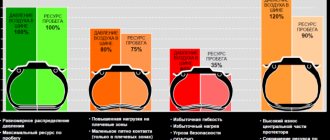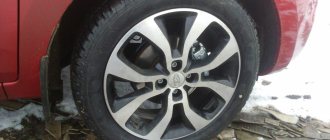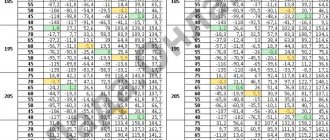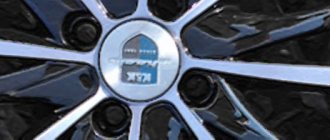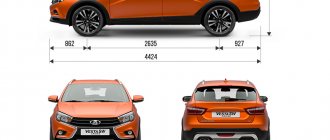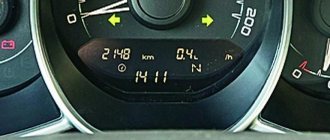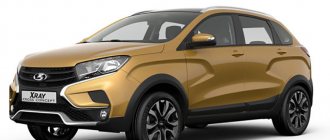Standard wheels
A car wheel consists of a disk and a tire, which have individual characteristics.
The AvtoVAZ concern indicates the standard tire size for the Lada Vesta car in the basic configuration - 185/65/R15 88 N (the manufacturer allows the use of T). It means:
- width – 185 mm;
- profile – 65% of 185 mm (120.25 mm);
- The tire must be mounted on a rim with a diameter of 15 inches;
- 88 – load capacity index 560 kg;
- H – speed index, up to 210 km/h (for T – up to 190 km/h).
Such tires under the name ArtMotion for AvtoVAZ are manufactured at Belshina OJSC; the products are characterized by moderate softness and good rubber wear resistance, low noise and excellent road holding. Belshina OJSC also produces tires with identical characteristics in a winter version - the ArtMotion Snow model.
In the basic configurations of the Lada Vesta, these tires are mounted on stamped steel rims of size 6J 15 ET 50 4x100 60.1 (as an option - light alloy models of the same dimensions ANNA-15 from the manufacturer K&K), which means:
- 6J – disk rim width (6 inches);
- 15 – mounting diameter in inches;
- ET 50 – offset 50 mm;
- 4x100 (PCD, bolt pattern) – the disk is secured with 4 bolts located around a circle with a diameter of 100 mm;
- 60.1(DIA) – size of the central (hub) hole.
For top-end configurations of Lada Vesta, the factory installs wheels with dimensions 195/55 R16 91 N (T allowed):
- width – 195 mm;
- profile height – 107.25 mm (55% of 195);
- R16 (mounting diameter of the disk) – 16 inches;
- 91 (load capacity index) – 615 kg;
- H (speed index) - up to 210 km/h (T is allowed - up to 190 km/h).
These EcoContact tires are supplied to AvtoVAZ by the German company Continental. They are mounted on light alloy wheels of the K&K company model Ptalomey-16 with dimensions 6Jx16 ET50 4x100 60.1, the geometric characteristics of which differ only in the mounting diameter - 16 inches.
For basic versions of Lada Vesta, installation of wheels of these dimensions on K&K alloy wheels is also possible as an additional option.
In the Luxe configuration of the Lada Vesta, for an additional fee, it is possible to install wheels even with 17-inch rims of the same model - Ptalomey-17.
For clarity, let’s summarize the correspondence between the sizes of tires and wheels of the Lada Vesta in a table.
What non-standard sizes can be supplied?
In addition to the standard wheels listed above, you can install tires of non-standard diameter on your Lada Vesta. When choosing such solutions, you should definitely adhere to a number of recommendations:
- when using rubber with a diameter of 15 inches, the tire composition must have increased strength - since the car will have greater inertia when cornering;
- for aggressive, fast driving - wheels with a diameter of 17 inches are best suited;
- Summer tires are best equipped with wheels with a diameter of 16 inches - such wheels can be equipped with tires with a sole width of 185 to 195 mm and a profile height of 55-60 mm.
Before installing and starting to use tires of non-standard sizes, the driver should “try on” them. Often, when the wheel width or profile height increases, the tread begins to touch the plastic fender liner. As a result, the fender liner itself may be broken, and the protector begins to quickly wear down on the plastic surface. Wheels that are too large often damage mudguards and the body. The appearance of cracks and chips in the paintwork causes serious trouble.
Alternative wheel sizes for Lada Vesta
Installing wheels of a different size on a car is not a rare situation, and the reasons for this can be different - from restoring the car after an accident to tuning. Let's consider common acceptable options for installing non-standard size wheels on a Lada Vesta, the pros and cons of this procedure, as well as errors that can lead to deterioration of the vehicle's performance and even premature failure of some components.
The situation when a car enthusiast decides to “change” his car to new tires of the standard size, but manufactured by another manufacturer, without replacing the wheels, does not require any special comments. However, there are rules here: all tires must have the same tread profile or the same degree of wear (differences in the tread profile of pairs of tires on the front and rear axles are allowed).
Replacing wheels on a Lada Vesta with your own hands
To replace it, you must go through the preparatory stage. To do this, place the car on a level surface, secure it with the parking brake, and you can engage first gear. You will need a standard tool for this procedure - a jack, a wheel wrench.
Before lifting the car with a jack, you should loosen the bolts holding the wheel. After this, a lifting device is installed under the car - its heel must exactly coincide with the standard place, which is called the “jack”. The car rises until the desired wheel lifts off the ground by 20-40 mm. Now you can completely unscrew the bolts, remove the wheel and install a new one, tightening the bolts as much as possible.
The jack is lowered, and with the help of a wrench, the wheel bolts are finally tightened crosswise with maximum force. After about a few hundred kilometers, you should check the tightness of the wheel bolts. The remaining wheels are replaced in the same way.
Unsuitability of disks of other Lada models
Wheel rims of size 185/55/R15 from the AvtoVAZ Grant, Priora and Kalina models cannot be installed on the Lada Vesta, even though at first glance they seem suitable. The diameter of the hole for the wheel hub of these cars is 58.5 mm, that is, 1.6 mm less.
But, even if this hole is bored on a lathe to the required size, the bolt pattern (PCD) of these products is 4x98, not 4x100, and 3 of the four mounting bolts will not be centered relative to the mounting holes, accordingly, the disk will not be aligned with the hub, and its rotation will be accompanied by beating.
Tips for using tires and wheels from AvtoVAZ
The Volzhsky Automobile Plant has established a list of wheel sizes in diameter and width, as well as the sizes and pressure values of rubber tires that can be installed on the Lada Vesta. The manufacturer regulates the following parameters:
- the size of the tire profile, its diameter, as well as the width of the protective tread;
- the inner diameter of the tire on which a disc of the appropriate size is installed;
- calculated maximum values of speed and load weight supported by tires;
- characteristics of the linear dimensions of the disk: width and offset (the amount of protrusion outward or inward from the rim axis);
- safe tire pressure.
The profile of a car tire is the normal size between the circles describing the outside of the tire and the rim. Its value is measured in millimeters, but the exact value is not usually indicated. The percentage component of the profile of the tire tread width is prescribed, which is measured in millimeters. The tire indicates the so-called “fitting” diameter of the rim that fits the given wheel. It is indicated in inches (1 inch = 25.4 mm).
The index, which characterizes the permissible load-carrying capacity of car rubber, is indicated by a two-digit or three-digit number ranging from 60 to 120, which corresponds to a certain weight value in kilograms. For speed coefficients, there is also a definition table in which index indicators are written using capital letters of the Latin alphabet (from Q to Z), which correspond to suitable speed indicators expressed in kilometers per hour.
The wheel rim has characteristic linear dimensions: diameter, width and offset. The width of a disk rim is indicated by a number and the Latin letter J. The letter indicates that the width is measured in inches, and the number characterizes the size. Standard tire inflation pressure values are also indicated by the manufacturer and are measured in megapascals (MPa) or atmospheres. The pressure value is checked using a pressure gauge.
AvtoVAZ advises not to allow such pressure in the tires, which differs significantly from what is indicated in the vehicle's passport recommendations. Using such tires for a long time, the driver thereby worsens the stability and controllability of Vesta.
Another nuance that can affect tire pressure is a worn spool valve, which allows air to leak. It is recommended to regularly check the condition of the valve. Installation of new tires is carried out at a service station, or independently using the appropriate equipment. After replacement, it is recommended to have Lada Vesta wheels balanced at a dealer station.
Article rating:
What tires can be installed on the Vesta Link to main publication
Related publications
- Which generator is suitable for the VAZ 2107 injector
Installing larger diameter discs
Large rims not only change the appearance of the car, but also affect its dynamics, maneuverability, and stability on the highway, and not always for the better.
When deciding on their installation, you should know the basic principle - the larger the diameter of the disk, the lower the height of the tire profile, because the size of the outer diameter of the wheel is tied to the size of the wheel arch - when turning, the tire should not touch or rest against anything at all steering wheel rotation range.
Testing the Lada Vesta over the course of a year showed acceptable wheel size options:
- tires for R15 wheels:
175/70 R15;
205/60 R15.
- tires for R16: 185/60 R16.
- tires for R17:
175/55 R17;
195/50 R17.
17-inch wheels were installed on the Concept version of the Lada Vesta. Technically, this sedan can also be equipped with R18 wheels, but the outer diameter of this wheel (669 mm), as well as the tire width (235 mm), differ significantly from the factory values and cannot be considered in the real conditions of Russian roads due to the too low profile as practical - defects in the road surface will quickly damage both tires and wheels, the price of which, due to their size, is several times higher than the cost of standard ones.
The effect of large-diameter wheels and low-profile tires on a car
Positive:
- increasing the style of the car and the effectiveness of the exterior;
- improvement of driving qualities - dynamics, road stability, steering sensitivity;
- better “absorption” of potholes compared to a smaller radius;
- with a tire profile from 55 – increased durability of the suspension;
- reducing the braking distance;
- increasing the efficiency of ABS and ESP.
Negative:
- uncomfortable driving due to sensitivity to road surface defects;
- restriction of use on roads with defective surfaces;
- the need for increased pressure control;
- greater need for kinetic energy at the start - higher fuel consumption;
- higher cost.
Low profile tire pressure
This parameter, ignored by novice car enthusiasts, is very important when operating cars with any tires, and especially with low-profile ones. The required tire pressure is always indicated by the vehicle manufacturer in the operating instructions and in an accessible place on the body, for the Lada Vesta - on the B pillar on the driver's side.
Low profile tires require increased attention to pressure, as insufficient pressure will make the wheels and suspension even more vulnerable to potholes and rocks on the road.
As many years of experience have shown, the pressure in low-profile tires must be maintained 15% higher than that specified by the manufacturer for wheels of the recommended size.
Choosing tires for different operating conditions
Winter becomes a real headache for car enthusiasts; some prefer not to use their cars during this period, while others have to buy winter tires. You cannot drive on summer tires in the cold season - their composition is not designed for low temperatures. Braking, starting to move, and driving become impossible.
Choosing winter tires
Large tires can be installed on Vesta, but for winter it is better to install smaller wheels. If R16 is used in summer, then R15 is recommended for winter. The tire width is also selected smaller. In winter, speed characteristics are not so important. Studded tires and so-called “Velcro” tires are available on the market. It is ideal for residents of large cities who rarely go off-road. Spikes are not needed on asphalt roads. For those who often travel on snowy, icy roads, they are definitely necessary.
Tread pattern selection
There are three types of drawing:
Tire tread pattern
- Symmetric. Both sides of the pattern are the same and have a wave or bridge shape. Equally effective on snow and ice. Loses its properties on snow porridge in the spring or after treatment with reagents.
- Directed. It is not afraid of snow, ice, and also does not lose its properties in slush. Not suitable for use on dry asphalt due to increased noise. The peculiarity of these tires is in the direction - they must be mounted strictly according to the direction of travel arrow, which is indicated on the outer side of the product with the inscription “Rotation”.
- Asymmetrical. In addition to all the advantages of the described figures, noise reduction and high speed characteristics are added. It is installed according to marks indicating the inside and outside with inscriptions on the sides - “Inside”/“Outside”. The only drawback is the high price.
To save money, you can use the directional option. If your budget allows, it is better to choose an asymmetrical pattern.
Selection by stud size
A regular thorn looks like a nail - this is the most common type. There are also other shapes - square, rectangle. At the same time, at speeds up to 60 km/h, the braking distance does not change in any way, and there is no point in paying more, because in winter it is unsafe to increase the speed. From popular brands you can choose the following:
- Nokian Hakkapeliitta 8 – is in the middle price range, the estimated cost is from 4 to 5 thousand rubles;
- Bridgestone Blizzak Spike-01 – from 3 thousand rubles;
- Yokohama Ice Guard F700Z – average price – 2 thousand rubles;
- Dunlop Ice Touch – average price – 2.7 thousand rubles;
- Michelin X-Ice North 3 – 3-3.5 thousand rubles;
- “Kama Euro” 519 and “Belshina” Bel-127 - up to 2 thousand rubles.
The choice is large, for high quality and brand you will have to pay a substantial amount. If your budget is limited, you can purchase domestically produced winter tires. They are cheaper, but this does not mean that their quality and efficiency are worse.
Choosing summer tires
Summer tires for cars are made from hard compounds, which is determined by temperature and speed operating conditions. These tires wear out more slowly and do not lose grip on hot asphalt. These wheels have a different tread pattern and depth from winter ones.
Tire size
Choose a size that matches the manufacturer's requirements. It is possible to use alternative options, but in this regard different points should be taken into account:
- If the outer diameter of the wheel turns out to be larger than the manufacturer allows, it will cling to the arch when driving over uneven surfaces and when turning.
- When installing tires with a large width, there will also be friction along the arches, which is unsafe and leads to rapid wear of the rubber.
- Installing tires with a low profile will make the suspension too stiff, which will lead to failure of the chassis components. But low-profile tires increase steering sensitivity, allowing you to better control the car when driving at high speeds. This is not the best option for driving on domestic roads.
- An excessively high profile reduces control efficiency; at high speed, there is a high risk of losing the tire from the rim, which will lead to an accident. Properly selected high-profile tires improve the smoothness of movement, easily absorb all potholes and bumps, and are able to preserve the life of the suspension.
Summer tires on the Lada Vesta should be wider (within reasonable limits), this increases the contact patch with the road surface and improves dynamic characteristics. But this will lead to increased fuel consumption and the risk of aquaplaning even at low speeds when driving through puddles. Based on this, we can conclude that when choosing the type of tires, many factors need to be taken into account. In most cases, it is advisable to stick to the size recommended by the manufacturer. For the average car driver in city mode, this is enough.
Tread selection
According to the type of pattern, there are symmetrical, asymmetrical and directional protectors. An inexpensive option is a standard tire with a non-directional pattern. It has average characteristics of controllability, comfort and aquaplaning prevention. In terms of price-quality ratio, it will be the best option for leisurely trips. If necessary, the tires can be placed on different sides.
Rubber with a directional pattern has better handling, comfort and prevents aquaplaning. One of the advantages of this pattern is the quick removal of water from the tread. They are installed in accordance with the direction of travel, so they cannot be mounted differently when rearranging the wheels between the right and left sides. Otherwise, control safety is sharply reduced.
Rubber with an asymmetric tread pattern is a universal option with equally good handling and comfort on various road surfaces. The outer part consists of larger and more rigid blocks, which improve cornering control. The tread pattern on the inside consists of smaller blocks and drains water more efficiently, increasing traction on wet asphalt. To ensure directional stability, there is a longitudinal stiffener rib in the middle. Such wheels can be moved from one side to the other. The only drawback is the high price compared to directional and non-directional tires.
Popular brands of summer tires for Lada Vesta include:
- TRIANGLE GROUP TR928 – cost does not exceed 2.5 thousand rubles;
- NOKIAN NORDMAN SX2 – from 3 thousand rubles;
- MICHELIN ENERGY XM2 – from 3.5 thousand rubles;
- YOKOHAMA GEOLANDAR SUV G055 – from 7 thousand rubles;
- HANKOOK VENTUS V12 EVO2 K12 – from 8 thousand rubles.
The most affordable option is Kama Euro and Belshina tires, the cost of which usually does not exceed 2 thousand rubles per tire.
Selection of all-season tires
The constant rise in prices for cars and related products forces car owners to look for ways to save money. One of its options is to buy universal tires. This type of tire is only suitable for countries where the climate is mild all year round. “All-season” vehicles are not suitable for the harsh winter months of the middle zone. When the temperature drops to 7 degrees, the elasticity of rubber with the “allseasons” index decreases, the braking distance increases and the risk of losing control increases. An all-season tire is a middle option between summer and winter, so you shouldn’t expect high performance from it.
“All-season tires” have a less frequent tread pattern compared to winter tires and are of medium softness. The side part has rounded shapes, dissected sipes, and a tread with deep recesses. For summer they show good grip qualities, but for snow and ice they are useless. You can identify such tires by the inscription “All Seasons”. It has no practical meaning - driving is allowed at temperatures not lower than -5 degrees. At lower temperatures the tire becomes too hard.
The advantage is that you don’t need to buy a set of winter and summer tires, which saves money. The issue of storing one of the sets is resolved, since the tires are always on the car. With the right choice, such tires can cope with snow (provided there is a mild winter).
“All-season” models have significantly more disadvantages. Use on ice and deep snow is ineffective and unsafe. At low temperatures, tires become tanned in the same way as summer tires, losing their grip and can cause an accident. Year-round use results in faster wear.
“All-season tires” cannot withstand high temperatures, become too soft, wear out faster and reduce control efficiency.
When buying such tires you need to adhere to some rules:
- Choose brands. There is no point in giving preference to domestic manufacturers because of lower prices. The quality in most cases corresponds to the price.
- Tread quality. Manufacturers produce tires for primary use in both summer and winter. The latter are more suitable for driving outside the city, as they do a good job of removing dirt and water. There is also a third type - mud tires. It has excellent traction and high cross-country ability, but when driving on asphalt they create a lot of noise at high speed.
When choosing, pay attention to the indices indicated on the bus. They must comply with the vehicle manufacturer's requirements. On the modern market there are several options that are most suitable for operation on the Lada Vesta:
- Pirelli Scorpion Verde Allseasons - average price about 10 thousand rubles;
- Yokohama Y534 – up to 8 thousand rubles;
- Cordiant off road – up to 5 thousand rubles.
For obvious reasons, domestic manufacturers were not included in this list.
How to choose wheels for Lada Vesta
In addition to the main sizes of tires and wheels, which clearly indicate their suitability or unsuitability for the Lada Vesta, there are other parameters and nuances, ignoring which when choosing is fraught with subsequent troubles.
Disc offset
This parameter (ET) is a critical characteristic, and when purchasing, it is better to be guided by the ET value specified by the car manufacturer.
Installing wide wheels with a reduced ET value increases the vehicle's stability, but at the same time increases the load on the wheel bearings, the consequences of their destruction on the move are unpredictable.
Reducing the offset is allowed by no more than 5-7 mm.
PCD parameter
This value (bolt pattern) must be observed absolutely when choosing new discs. If the PCD marking is different from the value specified in the machine's operating instructions, it will not be possible to install the discs.
Hub hole diameter (D)
Some manufacturers produce wheels with an oversized hole diameter for the hub - this circumstance allows them to be used using special inserts - centering rings on many car models. Therefore, a larger hole diameter for the hub is an easily solvable problem, in contrast to the opposite situation, when the hole is small.
And yet, there is a common situation when bolted fastening seems sufficient to the car enthusiast, and the use of centering rings is neglected. In this case, at speeds above 100 km/h, wheel runout begins, which can be difficult to diagnose, and pointless balancing costs follow.
Rim width
This parameter is important when choosing rims for existing tires - the use of excessively narrow or, conversely, wide rims distorts the geometry of the plane of contact of the tire with the road surface and worsens the dynamic characteristics of the car. In addition, when driving on snow or dirt, wide tires slip due to low specific pressure on the road, so when choosing the size of tires and wheels, you should take this factor into account.
Standard tires and their features
Tires for the Lada Vesta are produced by the Belarusian Belshina plant; it should be noted that they were specially designed for this car, their quality has been tested on the roads. These tires were tested at Spanish testing grounds, showing low noise levels and stability. The type of tires used on the Lada Vesta belongs to the ART Motion brand, which means that Spanish quality standards are used in the production of rubber. It is important to understand that rubber is also tested with the specified standards, and today they are considered one of the best for assessing the quality of tires.
Let us outline the advantages that Lada Vesta tires have:
- High road handling in all weather conditions. This became possible thanks to the use of special arc-shaped grooves that are located on the inside of the tire. They play the role of a drainage system and push water away from the surface of the wheel.
- Vehicle stability on turns, which is achieved due to enlarged relief blocks. They are located on the outside of the tire.
- Minimum noise - achieved through the use of a special protector.
- The vehicle's directional stability is ensured by three longitudinal grooves.
- Low rolling resistance. First of all, it allows you to improve the speed characteristics of the car and reduces fuel consumption several times.
- The traction qualities of the tires made it possible to completely eliminate slipping and provide a short braking distance.
- The quality of rubber remains at a high level, despite its low cost.
Depending on the configuration, various tires can be used on the Lada Vesta. So, if he decides to buy a luxury version, he will get a Continental size 195/55/R16
, which are produced at a German plant and are among the best on the world market. The factory equipment uses 16 and 17 inch alloy wheels from the K&K company, although the manufacturer of the Lada Vesta recommends using tires and wheels corresponding to size 16.
Winter tires for Lada Vesta Cross. We select the best option
The Lada Vesta Cross is a Russian-made SUV, purchasing which the driver expects high cross-country ability and adaptability to difficult road conditions, especially in winter. And these characteristics largely depend on the correct selection of tires.
The recommended tires for the Lada Vesta are 205/50 R17, so we will consider this particular size. The very first parameter that is considered when selecting winter tires is the absence or presence of studs on the tread. Determining this parameter is quite simple, since it directly depends on the region in which the car is used. For harsh and especially snowy winters, studs are recommended, as they provide reliable grip on ice, and for milder winters, you can choose winter tires with a deep tread, the so-called “Velcro”, which is less noisy and maneuvers well in a slurry of ice and snow, which is formed during a thaw.
As for the tire manufacturer, the choice here directly depends on the financial capabilities and desires of the owner. Manufacturers such as Nokian, Bridgestone and Continental have proven themselves best. They are distinguished by consistently high quality rubber and a long service life. Of the more affordable options, many drivers prefer Pirelli or Matador, which are produced in Russia and belong to the middle price category.
Caps for Vesta
Many car owners strive to ensure that their iron horse has a unique appearance. Not everyone has the opportunity to buy alloy tires, especially since high-quality models are not cheap, and alternative sizes will require different tires. In such a situation, it is optimal to put wheel caps on the wheels.
The main task is to improve the appearance. In addition to beauty, caps also perform a protective function, namely, they prevent dents, scratches and abrasions of the wheel rim.
Depending on the design, the cap can also keep excess dust off the brake pads, increasing their lifespan. As a rule, the cost of products is low. Usually the average price does not exceed 2,000–3,000 rubles for a set of 4 pieces.
Features of the caps
These accessories may vary in the shape of their profile (flat or convex). You can also buy metal options, but most often you can find plastic ones: more practical and inexpensive. By design, they can be closed or open, as well as in different colors.
Depending on the manufacturer, the caps may have different fastenings. There are models that are fixed with bolts. There are also those for which nylon clamps are sufficient. Plastic caps are much more popular than metal ones, because they are inexpensive, they are stronger and you don’t mind them. Their service life is not that long. The open shape of the caps does not hide corrosion well, but provides good cooling of the brakes.
The cost of products depends on various factors. The most acceptable option is a kit for installation on standard R15s; the original one will cost 1,500–2,000 rubles. Accordingly, the larger the radius, the higher the cost.
Installation of hoods
Any car owner can install them on Vesta with his own hands; there is nothing difficult about it. Before starting work, you need to clean the disk from dirt and corrosion. If necessary, it is necessary to correct irregularities and dents, if any.
There is a recess on the cap for the nipple for pumping air into the tires; it must be aligned with the valve on the wheel. Next, you should make sure that the metal ring on the inside is in the grooves of the latches (the ring ensures equal pressure around the circumference). All that remains is to place the cap on the disk and check the reliability. Additionally, you can use plastic clamps to secure the cap to the wheel more firmly: this prevents the accessory from flying out when driving, which is not uncommon.
About standard disks
Two types can be installed on Vesta: stamped and cast. Standard size recommended by the manufacturer: R15 and R16. Each type has its own characteristics, pros and cons.
Stamped
Stamped R15s are provided as a factory option as standard. The tire size is 175/70 R15. Choose stampings both from an official dealer and in many specialized stores.
Vesta alloy wheels
They are made from special alloys based on aluminum plus additives for rigidity and strength (strontium, titanium, magnesium). The manufacturing process for alloy wheels involves high pressure to produce a durable design. The final shape is achieved on a high-tech milling machine. The higher cost of alloy wheels is due to the complexity of production. Casting is lightweight, but the products are less resistant to mechanical damage.
Depending on the configuration, the Lada Vesta can be equipped with two cast and stamped wheels of different sizes:
- in the basic configuration R15 with tires of 175/70 and 205/60;
- in more expensive versions of the R16, stamped or cast (Luxury and Cross equipment) with 185/60 tires.
Unlike stamped wheels, alloy wheels come in a variety of designs.
Casting can be ordered as a separate option for any configuration or purchased in specialized stores. If for stamped ones you need to pay no more than 2,500 rubles (on average 1,500), then the cost of alloy wheels starts from 3,000 (R15) and 4,000 rubles. (R16) for one copy. Depending on the manufacturer, the cost can increase several times.
Selection of disks for Vesta
The quality of Russian roads leaves much to be desired, so sooner or later the rollers will have to be replaced, since they wear out much faster on such roads. Another reason for replacement is the desire to change stamped to casting or choose a different design.
In such cases, there is no point in recommending standard wheels with a radius of 15; it would be better to choose R16 or R17. For 16's you can use tire sizes 175/70 and 205/60. For 17's the optimal tires are 175/50 and 195/50.
The following discs are recommended by the manufacturer:
But that doesn't mean others aren't suitable. There is a huge arsenal of discs of various types and at different prices. When choosing them for Vesta, you should take into account that the bolt pattern (the distance between the wheel bolts) differs from that used on other VAZ cars. As before, there are 4 bolts for fastening, but if previously the diameter between them was 98 mm, then on Vesta the bolt pattern is 4/100.
You should not give preference to deliberately large disks (from 18 radius).
At the same time, aesthetically the car will look original. But with such rollers you will have to use low profile tires. And this, given the condition of the roads, will make everyday trips unpleasant.
Rating of alloy wheels for Vesta
For convenience, this shortlist is compiled from bottom to top, i.e. the best brand will be at the end. The top casting includes the following brands.
- LS Wheels. Manufacturer from Taiwan. The products are certified by Rosstandart and adapted to Russian operating conditions. Pros: a wide variety of castings, attractive design and low cost. Of the minuses: not the best quality.
- Alcasta. This brand is preferred by connoisseurs of classics and strict design. The company's products have been sold in Russia since 2013. They are distinguished by excellent balancing from the factory, light weight and low price. The disadvantages include the softness of the metal and poor paint coverage.
- LegeArtis. Stylish and high-quality alloy wheels, despite the fact that they are made in China. Production is carefully controlled at every stage, products undergo multi-level testing. Modern technologies are used, but the quality of the metal leaves much to be desired; at high speeds and when falling into holes, cracks and other mechanical damage may appear.
- Replica. A brand that produces copies of original wheels from the world's leading automakers. The quality of the discs depends on the factory, and there are several of them. Over the course of many years of history, the company has gained an impeccable reputation. In addition to high quality and a large selection, car enthusiasts will be pleased with low prices. However, on some copies, namely those included in the kit, there are different weights and incorrect geometry.
- Dotz. One of the world's best disc manufacturers from Germany. The company is narrow-profile and deals exclusively with car wheels, so the product is of a high level. All products comply with international standards and are tested at every stage of production. In addition to quality and beautiful design, the brand offers a range of prices and a wide variety. Oddly enough, there are virtually no shortcomings.
- K&K. The products are characterized as high quality, inexpensive and reliable. This is a Russian product, and it is the wheels of this manufacturer that AvtoVAZ uses. Parts are manufactured using modern equipment and meet international standards. There are no minuses as such; the pluses include an interesting design.
K&K is a Russian manufacturer, a leader in the rating of production of alloy wheels for Vesta.
Of course, the list of trustworthy manufacturers can be supplemented with at least a dozen other brands. The car owner can choose from them depending on financial capabilities and personal desires.
Top best manufacturers of stamped wheels
On the market you can find dozens of brands that produce reliable stamped wheels. The list of the best includes only the most popular brands with a long history.
- Asterro. Manufacturer of stampings from Uzbekistan. The main production is concentrated in China. The main advantage of casting from this company is high-quality welding and painting. The products are available to a wide range of car enthusiasts, making them popular in the market. Disadvantage: their heavy weight and simple, uncomplicated design.
- TZSK. One of the most popular Russian manufacturers of wheel rims. Production is established in Tolyatti. Thanks to modern technologies and equipment, the products are not inferior in quality to discs from Europe. A huge assortment allows you to choose a model that is suitable in size and design. The products are distinguished by their low price and light weight. Unfortunately, there are counterfeit products under this brand, and the original has weak coloring.
- KRKZ. A Ukrainian manufacturer that specializes not only in stamped automobile wheels. There is a range of products for trucks, tractors and agricultural machinery. The plant cooperates with many European organizations, which helps improve product quality. Stamped discs of this brand allow you to save money, while they are durable and have a long service life. The manufacturer produces only standard-type discs, which are heavy, and these are their main disadvantages.
- TREBL. A Chinese company working using original stamping technology. The products are characterized by low price, good performance characteristics and high quality. Their main drawback is their weak coloring, but the minus is insignificant, so many motorists prefer not to pay attention to it.
You can also add the Mefro company - wheels of real German quality. Stamping from this manufacturer is in demand in different countries. The company produces products for trucks, trailers, special and agricultural equipment. One of the disadvantages is the possibility of purchasing a fake, so you need to buy them in specialized or branded stores. They are not overpriced and are consistent with the quality. These products are reliable and have a long service life.
Be careful when purchasing: many stampings are fake.
Factory alloy wheels
Lada Vesta wheel sizes, standard and alternative
At the factory, alloy wheels are installed on luxury trim levels. If you have seen a Lada Vesta in the photo with 15 alloy wheels, it means that the driver of the car installed them himself, or it is a luxury one. Typically, the manufacturer installs products from the Russian company K&K. It is a leading manufacturer of die-cast wheels. He has been making rims for over 20 years since '91. Kik has reliable equipment. The company provides a substantial warranty on the wheels. The Lada Vesta in the photo on 16-inch alloy wheels looks beautiful and stylish. It is not equipped with alloy wheels, you can pay extra for them.
Lada Vesta is equipped with high-quality factory wheels. They have practical performance characteristics and most buyers do not change them for many years. But some people see the Lada Vesta in the photo on 17-inch alloy wheels and want to install these for themselves. Be aware that then you will have to install low-profile tires, the ride will become less comfortable. But the solution has advantages, discussed earlier.
https://youtube.com/watch?v=borqM8R7Bis
